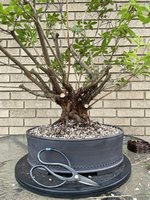Deep Sea Diver
Imperial Masterpiece
Oh yes… One thing you might think of doing is take some cuttings of each now. You may need these later. If there is space/material 1/2 dozen of each should do you.
cheers
DSD sends
cheers
DSD sends
Some varieties seem to have this growth habit. 'Sao tome' has small leaves does this and many years ago I worked with some 'gumpo' type azaleas that had small leaves and similar ground layering growth habit.Straight out of the ground into a sprawling mess really no trunk at all.
Some of these has really small leaves.






Can you expound on the pruning? I left foliage on thinking this would help. Would the tree back bud well? Haven’t take these back too hard while in the ground but have seen some back budding.Good job digging the azalea out. Herbert is a very cold hardy azalea, so good for your neck of the woods.
One thing you might do is cut all trunk stubs back flush, convex, following the trunk line. Not concave like most other trees.
Next, seal all cuts great then 1/8” . Azlaeas tend to dehydrate easily.
Finally, after wetting the root ball down thoroughly, get a probe or chopstick and push it through the rootball multiple times to near bottom, by the trunk, angle the probe into the area under the trunk. If this doesn’t work use a 3/16-1/4” long drill bit and use that… just gentle pressure, allowing the bit to find its own way through.
This action will enhance water flow throughout the rootball, including the shin. Landscape azaleas are notorious for non percolating rootballs. I’ve personally received landscape azaleas that weren’t completely rootwashed by the past owners…. only to find the area under the trunk completely hydrophobic, packed tight with native soil (years after digging). Getting water to penetrate into this will enhance future growth.
Cheers
DSD sends
You mentionned it and used the right word...I use knob cutters CAREFULLY until I’m close, then out come the chisels or knife.
Thanks Leo! Certainly a good 5-8 degrees cooler with the lake insulating the lakeshore, but I'm not too far inland. We did have dew points around 70-75 last week with 90 degree temps... but that scenario is roughly our peak heat. I waited for this week to dig it up as we are now dew points in the 50's with 80 degrees as a high, much more comfortable, and to your point, 50's in the morning!@Brad in GR - sorry, I've been off line lately. @Deep Sea Diver has steered you correctly. I would have kept about 50% to 75% of the foliage, if possible. But you have enough you should be fine. I would be cautious about using a drill bit to loosen the "shin" in a fine ceramic pot, the risk is breaking the pot. But all in all good advice. Being in Grand Rapids area, your mild summers, compared to the rest of the country, make summer a pretty good season for repotting. August is when a lot of work is done in the blueberry fields. Sadly, we sold the farm. Actually, I don't miss the work, but I do miss the delightfully cool August mornings.
I already saw your other post and made some comments.Collected this one, This thread definitely gives me hope!!!
